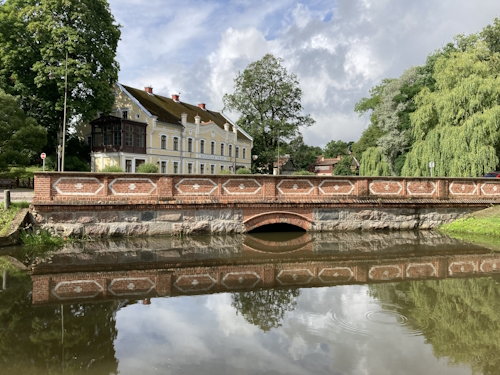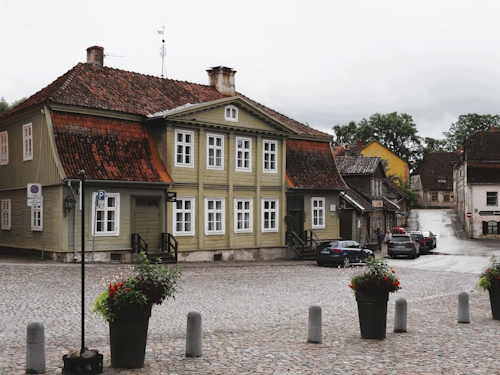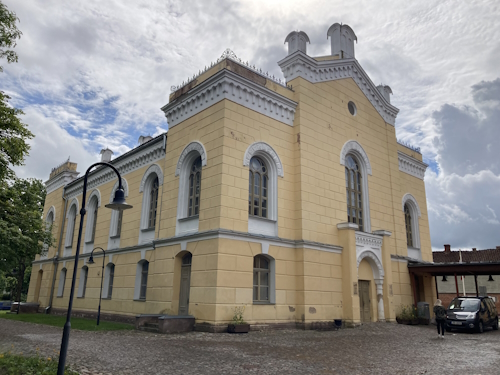Blog TWHS Visits
WHC 2023: Kuldīga
I am generally happy to spend the summer months of July and August at home, but I always plan a mini-break in Europe halfway through just to not get bored. So in April I took my chances and booked a 4D/3N trip for early August to Latvia and Denmark to check out two upcoming nominations: Kuldiga and Trelleborg. It turned out that I had a lucky hand in choosing these two, as they both got positive recommendations from ICOMOS and will almost surely be inscribed in September 2023. As Kuldiga is the lesser-known of the two, I will focus my report on that Latvian town.
Although I’d wanted to go there from Riga by public transport, there are no direct buses and connections seem infrequent. So I rented a car from the airport and drove there easily in 1.5 hours. Kuldiga lies deep in the countryside, and it certainly looks like you’re arriving at something important. One enters town via the large new stone bridge (a one-way street), and there is even a parking lot for tour buses. The streets were also filled with parked cars – this is really a popular destination for Latvian daytrippers.
Kuldiga (named Goldingen at the time) is strongly linked to the peculiar history of the ministate of the Duchy of Courland. Although their home base in Europe was tiny, they managed to establish colonies in Gambia and Tobago. That all happened in the 17th century, but unfortunately, there are few tangible links with today’s town. Its older buildings mostly date from the 19th century. The setting of the town, along a river and next to a ‘waterfall’ (more like rapids), is its main strength. The shape of the town has been unchanged for centuries.
I saw no banners or other adverts to announce the WH nomination (they’re obviously more modest than Schwerin). The only thing geared at international tourists seems to be the new direction signs, which are both in Latvian and English. There’s little interpretation of the sights: some buildings have an enigmatic name shield like “Dwelling House” and the former Synagogue (now a Library, photo 3) isn’t signposted at all. Most buildings aren’t in great shape and it is unclear what their use is nowadays.
The signs post to places all over town, but only a part of it lies in the core zone: the area on a hill near the waterfall plus the streets with historic houses leading towards the Old Town Hall. As I am writing this only half a day after my visit, I find it hard to name any sight that stayed with me. There are a few timber-framed buildings, there's the much-photographed view from Pasta Street #5 towards the oldest wooden building in town next to a canal and there is a large Lutheran cathedral. My favourite building was the former District Court (photo 1).
Kuldiga’s Nomination Dossier does its utmost to link the unique Courland history with what can be seen on the ground. They’ve put in so much effort that after reading it I felt it would get the sympathy vote. But to me, it still feels like a small town jumping on the tourism bandwagon - and maybe rightly so as there probably isn't anything comparable in the west of Latvia. ICOMOS in its evaluation dismisses most of Kuldiga’s claims, didn’t find the Courland history too relevant and Kuldiga even wasn’t the economically and politically most prominent town in Courland anyway. But there’s a plot twist of a magnitude I can’t remember ever having seen from ICOMOS before – hey, why won't we inscribe it on different grounds? It is a historic town with multiple layers from the 13th to the early 20th centuries. And then we swap the proposed criterion 3 for 5. During the process, the Latvians even changed the boundaries of the nominated property on the advice of ICOMOS and also altered this in the Latvian legislation. Oh, and of course we will rename the site as well to “Old Town of Kuldiga”….
Els - 6 August 2023
Comments
Nan 6 August 2023
Weird prcoess by ICOMOS to rewrite on the fly. But probably they figured better to put OUV right before a site gets inscribed on wrong criteria via political machinations.
Generally, a historical town(scape) in Eastern Europe / Baltics feels like it's okay to be added as rewritten by ICOMOS: And happy to get a reason to go back to Lativa/Riga for an extended weekend.


